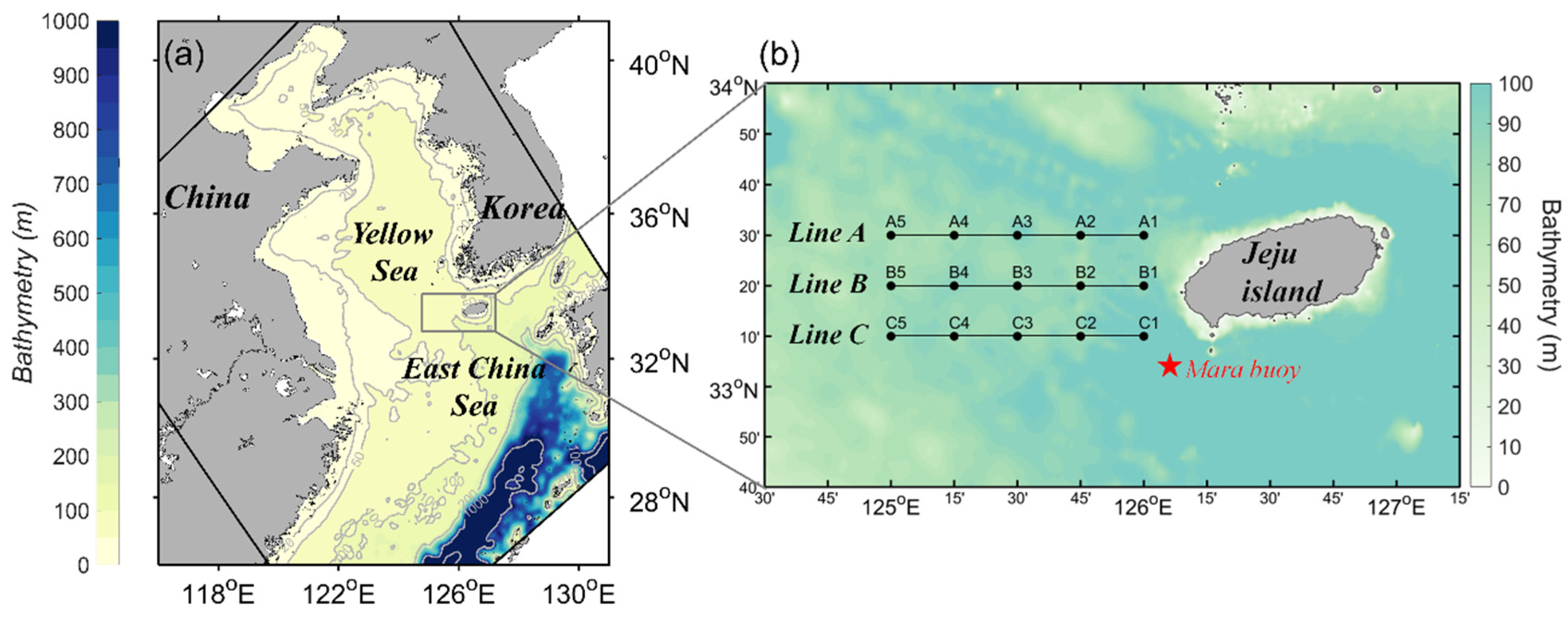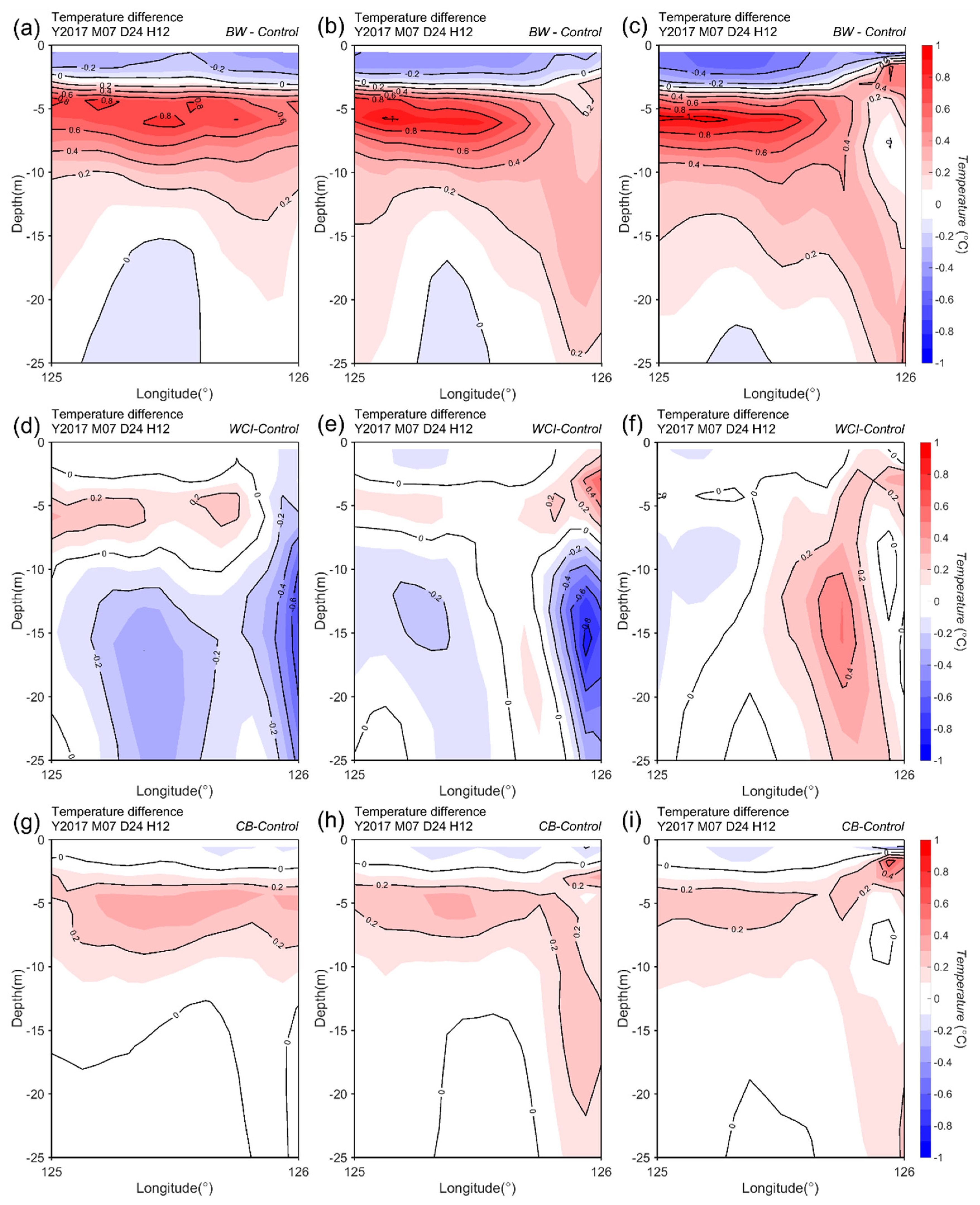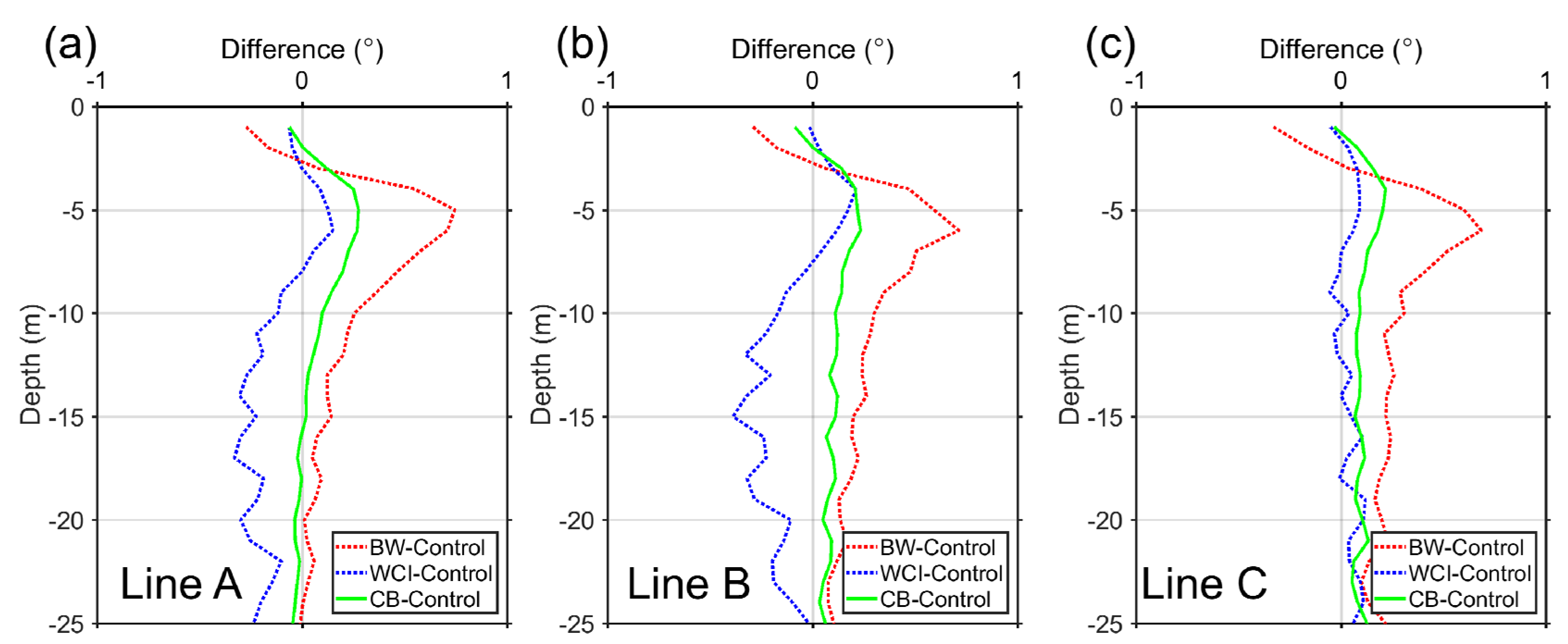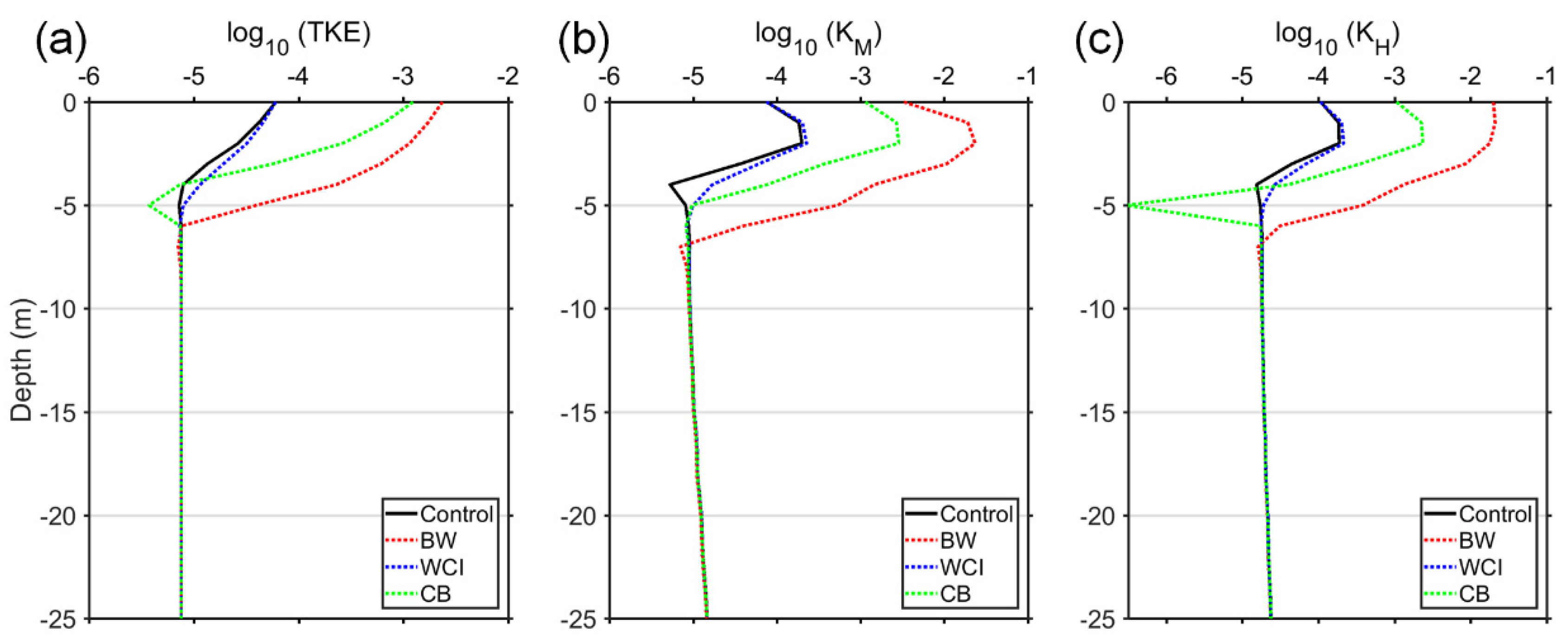Effect of Breaking Waves on Near-Surface Mixing in an Ocean-Wave Coupling System under Calm Wind Conditions
Abstract
:1. Introduction
2. Modeling System
2.1. Model Configurations
2.2. Experimental Design
3. Results
3.1. Model Validation
3.2. Effect of Waves on the Ocean-Surface’s Thermal Structure
4. Discussion
4.1. Surface Thermal Mixing Induced by BW
4.2. Effect of Swell-Related BW
5. Summary
Author Contributions
Funding
Acknowledgments
Conflicts of Interest
References
- Lim, S.; Jang, C.J.; Park, J. Climatology of the mixed layer depth in the East/Japan Sea. J. Mar. Syst. 2012, 96, 1–14. [Google Scholar] [CrossRef]
- Rimac, A. The Role of Wind Induced Near-Inertial Waves on the Energetics of the Ocean. Ph.D. Thesis, Universität Hamburg, Hamburg, Germany, 2014. [Google Scholar]
- Qiao, F.; Huang, C.J. Comparison between vertical shear mixing and surface wave-induced mixing in the extratropical ocean. J. Geophys. Res. Ocean. 2012, 117. [Google Scholar] [CrossRef]
- Huang, C.J.; Qiao, F.; Shu, Q.; Song, Z. Evaluating austral summer mixed-layer response to surface wave-induced mixing in the Southern Ocean. J. Geophys. Res. Ocean. 2012, 117. [Google Scholar] [CrossRef] [Green Version]
- Wu, L.; Rutgersson, A.; Sahlée, E. Upper-ocean mixing due to surface gravity waves. J. Geophys. Res. Ocean. 2015, 120, 8210–8228. [Google Scholar] [CrossRef] [Green Version]
- Rascle, N.; Ardhuin, F.; Terray, E.A. Drift and mixing under the ocean surface: A coherent one-dimensional description with application to unstratified conditions. J. Geophys. Res. Ocean. 2006, 111. [Google Scholar] [CrossRef] [Green Version]
- Walsh, K.; Govekar, P.; Babanin, A.V.; Ghantous, M.; Spence, P.; Scoccimarro, E. The effect on simulated ocean climate of a parameterization of unbroken wave-induced mixing incorporated into the k-epsilon mixing scheme. J. Adv. Modeling Earth Syst. 2017, 9, 735–758. [Google Scholar] [CrossRef]
- Wang, Y.; Qiao, F.; Fang, G.; Wei, Z. Application of wave-induced vertical mixing to the K profile parameterization scheme. J. Geophys. Res. Ocean. 2010, 115. [Google Scholar] [CrossRef]
- Song, Z.; Qiao, F.; Song, Y. Response of the equatorial basin-wide SST to non-breaking surface wave-induced mixing in a climate model: An amendment to tropical bias. J. Geophys. Res. Ocean. 2012, 117. [Google Scholar] [CrossRef]
- Bruneau, N.; Toumi, R.; Wang, S. Impact of wave whitecapping on land falling tropical cyclones. Sci. Rep. 2018, 8, 1–11. [Google Scholar] [CrossRef] [Green Version]
- Aijaz, S.; Ghantous, M.; Babanin, A.V.; Ginis, I.; Thomas, B.; Wake, G. Nonbreaking wave-induced mixing in upper ocean during tropical cyclones using coupled hurricane-ocean-wave modeling. J. Geophys. Res. Ocean. 2017, 122, 3939–3963. [Google Scholar] [CrossRef] [Green Version]
- Wada, A.; Niino, H.; Nakano, H. Roles of vertical turbulent mixing in the ocean response to Typhoon Rex (1998). J. Oceanogr. 2009, 65, 373–396. [Google Scholar] [CrossRef]
- Lewis, H.W.; Castillo Sanchez, J.M.; Siddorn, J.; King, R.R.; Tonani, M.; Saulter, A.; Sykes, P.; Pequignet, A.-C.; Weedon, G.P.; Palmer, T.; et al. Can wave coupling improve operational regional ocean forecasts for the north-west European Shelf. Ocean Sci. 2019, 15, 669–690. [Google Scholar] [CrossRef] [Green Version]
- Kantha, L.; Lass, H.U.; Prandke, H. A note on Stokes production of turbulence kinetic energy in the oceanic mixed layer: Observations in the Baltic Sea. Ocean Dyn. 2010, 60, 171–180. [Google Scholar] [CrossRef]
- Paskyabi, M.B.; Fer, I.; Jenkins, A.D. Surface gravity wave effects on the upper ocean boundary layer: Modification of a one-dimensional vertical mixing model. Cont. Shelf Res. 2012, 38, 63–78. [Google Scholar] [CrossRef] [Green Version]
- Kumar, N.; Feddersen, F. The effect of Stokes drift and transient rip currents on the inner shelf. Part II: With stratification. J. Phys. Oceanogr. 2017, 47, 243–260. [Google Scholar] [CrossRef]
- Chune, S.L.; Aouf, L. Wave effects in global ocean modeling: Parametrizations vs. forcing from a wave model. Ocean Dyn. 2018, 68, 1739–1758. [Google Scholar] [CrossRef]
- Craig, P.D.; Banner, M.L. Modeling wave-enhanced turbulence in the ocean surface layer. J. Phys. Oceanogr. 1994, 24, 2546–2559. [Google Scholar] [CrossRef] [Green Version]
- Breivik, Ø.; Mogensen, K.; Bidlot, J.R.; Balmaseda, M.A.; Janssen, P.A. Surface wave effects in the NEMO ocean model: Forced and coupled experiments. J. Geophys. Res. Ocean. 2015, 120, 2973–2992. [Google Scholar] [CrossRef] [Green Version]
- Rascle, N.; Chapron, B.; Ardhuin, F.; Soloviev, A. A note on the direct injection of turbulence by breaking waves. Ocean Model. 2013, 70, 145–151. [Google Scholar] [CrossRef] [Green Version]
- Ardhuin, F.; Orfila, A. Wind waves. New Front. Oper. Oceanogr. 2018, 393–422. [Google Scholar] [CrossRef] [Green Version]
- Carniel, S.; Warner, J.C.; Chiggiato, J.; Sclavo, M. Investigating the impact of surface wave breaking on modeling the trajectories of drifters in the northern Adriatic Sea during a wind-storm event. Ocean Model. 2009, 30, 225–239. [Google Scholar] [CrossRef]
- Lie, H.J.; Cho, C.H.; Lee, J.H.; Lee, S.; Tang, Y. Seasonal variation of the Cheju warm current in the northern East China Sea. J. Oceanogr. 2000, 56, 197–211. [Google Scholar] [CrossRef]
- Moon, J.H.; Hirose, N.; Yoon, J.H. Comparison of wind and tidal contributions to seasonal circulation of the Yellow Sea. J. Geophys. Res. Ocean. 2009, 114. [Google Scholar] [CrossRef]
- Yongzeng, Y.; Fangli, Q.; Changshui, X.; Jian, M.; Yeli, Y. Wave-induced mixing in the Yellow Sea. Chin. J. Oceanol. Limnol. 2004, 22, 322–326. [Google Scholar] [CrossRef]
- Huang, D.; Zhang, T.; Zhou, F. Sea-surface temperature fronts in the Yellow and East China Seas from TRMM microwave imager data. Deep Sea Res. Part Ii Top. Stud. Oceanogr. 2010, 57, 1017–1024. [Google Scholar] [CrossRef]
- Warner, J.C.; Armstrong, B.; He, R.; Zambon, J.B. Development of a coupled ocean–atmosphere–wave–sediment transport (COAWST) modeling system. Ocean Model. 2010, 35, 230–244. [Google Scholar] [CrossRef] [Green Version]
- Egbert, G.D.; Erofeeva, S.Y. Efficient inverse modeling of barotropic ocean tides. J. Atmos. Ocean. Technol. 2002, 19, 183–204. [Google Scholar] [CrossRef] [Green Version]
- Fairall, C.W.; Bradley, E.F.; Hare, J.E.; Grachev, A.A.; Edson, J.B. Bulk parameterization of air–sea fluxes: Updates and verification for the COARE algorithm. J. Clim. 2003, 16, 571–591. [Google Scholar] [CrossRef]
- Umlauf, L.; Burchard, H. A generic length-scale equation for geophysical turbulence models. J. Mar. Res. 2003, 61, 235–265. [Google Scholar] [CrossRef]
- Warner, J.C.; Sherwood, C.R.; Arango, H.G.; Signell, R.P. Performance of four turbulence closure models implemented using a generic length scale method. Ocean Model. 2005, 8, 81–113. [Google Scholar] [CrossRef]
- Booij NR, R.C.; Ris, R.C.; Holthuijsen, L.H. A third-generation wave model for coastal regions: 1. Model description and validation. J. Geophys. Res. Ocean. 1999, 104, 7649–7666. [Google Scholar] [CrossRef] [Green Version]
- Madsen, O.S.; Poon, Y.K.; Graber, H.C. Spectral wave attenuation by bottom friction: Theory. In Coastal Engineering 1988; 1989; pp. 492–504. Available online: http://ccrm.vims.edu/yinglong/wiki_files/Manual_SED2D.pdf (accessed on 23 June 2020).
- Battjes, J.A.; Janssen, J.P.F.M. Energy loss and set-up due to breaking of random waves. In Coastal Engineering 1978; 1978; pp. 569–587. Available online: https://icce-ojs-tamu.tdl.org/icce/index.php/icce/article/view/3294 (accessed on 23 June 2020).
- Komen, G.J.; Hasselmann, S.; Hasselmann, K. On the existence of a fully developed wind-sea spectrum. J. Phys. Oceanogr. 1984, 14, 1271–1285. [Google Scholar] [CrossRef]
- Hasselmann, K. On the spectral dissipation of ocean waves due to white capping. Bound. Layer Meteorol. 1974, 6, 107–127. [Google Scholar] [CrossRef]
- Tolman, H.L. A third-generation model for wind waves on slowly varying, unsteady, and inhomogeneous depths and currents. J. Phys. Oceanogr. 1991, 21, 782–797. [Google Scholar] [CrossRef]
- Jacob, R.; Larson, J.; Ong, E. M × N communication and parallel interpolation in Community Climate System Model Version 3 using the model coupling toolkit. Int. J. High Perform. Comput. Appl. 2005, 19, 293–307. [Google Scholar] [CrossRef]
- Larson, J.; Jacob, R.; Ong, E. The model coupling toolkit: A new Fortran90 toolkit for building multiphysics parallel coupled models. Int. J. High Perform. Comput. Appl. 2005, 19, 277–292. [Google Scholar] [CrossRef]
- Kirby, J.T.; Chen, T.M. Surface waves on vertically sheared flows: Approximate dispersion relations. J. Geophys. Res. Ocean. 1989, 94, 1013–1027. [Google Scholar] [CrossRef] [Green Version]
- Moghimi, S.; Thomson, J.; Özkan-Haller, T.; Umlauf, L.; Zippel, S. On the modeling of wave-enhanced turbulence nearshore. Ocean Model. 2016, 103, 118–132. [Google Scholar] [CrossRef] [Green Version]
- Stacey, M.W. Simulation of the wind-forced near-surface circulation in Knight Inlet: A parameterization of the roughness length. J. Phys. Oceanogr. 1999, 29, 1363–1367. [Google Scholar] [CrossRef]
- Charnock, H. Wind stress on a water surface. Q. J. R. Meteorol. Soc. 1955, 81, 639–640. [Google Scholar] [CrossRef]
- Kumar, N.; Voulgaris, G.; Warner, J.C.; Olabarrieta, M. Implementation of the vortex force formalism in the coupled ocean-atmosphere-wave-sediment transport (COAWST) modeling system for inner shelf and surf zone applications. Ocean Model. 2012, 47, 65–95. [Google Scholar] [CrossRef]
- Terray, E.A.; Drennan, W.M.; Donelan, M.A. The vertical structure of shear and dissipation in the ocean surface layer. In The Wind-Driven Air–Sea Interface. Electromagnetic and Acoustic Sensing, Wave Dynamics and Turbulent Fluxes; Banner, M.L., Ed.; School of Mathematics, University of NSW: Sydney, Australia, 1999; pp. 239–245. [Google Scholar]
- Willmott, C.J.; Robeson, S.M.; Matsuura, K. A refined index of model performance. Int. J. Climatol. 2012, 32, 2088–2094. [Google Scholar] [CrossRef]
- Lee, J.H.; Pang, I.C.; Moon, J.H. Contribution of the Yellow Sea bottom cold water to the abnormal cooling of sea surface temperature in the summer of 2011. J. Geophys. Res. Ocean. 2016, 121, 3777–3789. [Google Scholar] [CrossRef]









| Wave Effects on the Ocean | Uncoupled | Coupled | ||
|---|---|---|---|---|
| Control | CB | BW | WCI | |
| Breaking wave | Wind-based parameterization (Equation (3)) | Wave dissipation energy ( in Equation (1) from the wave model) | ||
| Wave-Current interaction | Stokes-Coriolis force, Stokes drift advection, Vortex force (Kumar et al. 2012) | |||
| Bias | RMSE | Correlation | IOA | |
|---|---|---|---|---|
| BW | −0.02 | 0.38 | 0.76 | 0.67 |
| WCI | −0.02 | 0.39 | 0.76 | 0.66 |
© 2020 by the authors. Licensee MDPI, Basel, Switzerland. This article is an open access article distributed under the terms and conditions of the Creative Commons Attribution (CC BY) license (http://creativecommons.org/licenses/by/4.0/).
Share and Cite
Hong, J.-S.; Moon, J.-H.; Kim, T. Effect of Breaking Waves on Near-Surface Mixing in an Ocean-Wave Coupling System under Calm Wind Conditions. J. Mar. Sci. Eng. 2020, 8, 540. https://doi.org/10.3390/jmse8070540
Hong J-S, Moon J-H, Kim T. Effect of Breaking Waves on Near-Surface Mixing in an Ocean-Wave Coupling System under Calm Wind Conditions. Journal of Marine Science and Engineering. 2020; 8(7):540. https://doi.org/10.3390/jmse8070540
Chicago/Turabian StyleHong, Ji-Seok, Jae-Hong Moon, and Taekyun Kim. 2020. "Effect of Breaking Waves on Near-Surface Mixing in an Ocean-Wave Coupling System under Calm Wind Conditions" Journal of Marine Science and Engineering 8, no. 7: 540. https://doi.org/10.3390/jmse8070540





